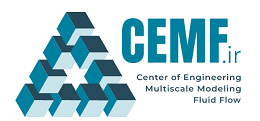Many process industries – such as gasification, fluid catalytic cracking (FCC), polymerization of olefins, catalytic reforming processes, tubular fixed bed reactors, and etc.- contain single or multi-phase fluid flow. The nature of these flows is multiscale, giving rise to the complexity of the flow/kinetic behavior of the process. The term multiscale means that small scale phenomena (with small length- and time-scale) determine the upper-scale phenomena and vice versa (visit here). Length-scales of affecting phenomena may vary from micro-scale (a few micrometers) to meso-scale (a few millimeters) to macro-scale (a few meters) and the time-scales may vary from 10-6 s to a few minutes. In these conditions, multiscale modeling can be a good solution. Capturing all the flow/kinetics features in a process industry requires proper modeling tools to simulate all the required details (in various time- and legnth-scales) of the processes.

As an example, the above picture shows the multiscale modeling strategy for a sample industrial process, a catalytic packed bed reactor. You see the schematic of modeling at various scales:
(A): 1-D model for the reactor with kinetic, heat and species balance. This model is what we can apply in plant simulation alongside other unit operation (Length scales: a few meters, plant size).
(B): 3-D model for the whole reactor with kinetic, mass, heat and species balances. The heat coupling between shell-side and tube side is done (Length scales: a few centimetres to a few meters, up to plant size).
(C): Resolved 3-D model for flow around catalysts and heat and species balances for only tube of the reactor. The resolved modeling gives the bed thermal and mass transfer properties in combination with reaction (Length scales: a few centimetres, smaller than pilot size).
(D): Detailed reaction-diffusion model inside one catalyst. This reveals the apparent (shape dependent) reaction kinetics and will provide the best catalyst shape for higher yield and conversion (Length scale: up to a few millimetres).
At various scales, a different set of details are included into the model. Larger modeling scales can be applied to larger processing units while neglecting more details. Our solution to ensure that our model in industrial scale includes all the necessary details, is small-to-large scale approach (in multiscale modeling). We start with the smallest possible/necessary modeling scale. The detailed results are analyzed and the results are integrated into the larger-scale model. This hierarchy is followed up to the final model scale (industrial-scale).
We in CEMF use various tools to simulate reacting and non-reactive flows at various length- and time-scales (multiscale modeling). For engineering, design, optimization and troubleshooting of these processes, a detailed information of the undergoing phenomena is required. These information can be the velocity and pressure profile of the flow, temperature or concentration variation, kinetics of reactions, mixing and turbulence and heat transfer rate. We use various tools to perform simulations at various scales.
- Computational fluid dynamics (CFD) is one of the pioneering tools which can provide such great insight into single and multi-phase flow at various length and time scales. Various turbulent models such as RANS and LES for simulating single phase fluid flow as well as Two Fluid Model (TFM) and filtered TFM with proper sub-models for two phase flows can be used in this context. OpenFOAM® is a reliable, open-source package which also allows the customization for the process of interest, is used in CEMF. CFD-DEM is another powerful modeling approach that we used for simulating two-phase flows. We have developed our own parallel solvers.
- Discrete Element Method (DEM) is the other modeling method for precise simulation of granular flows. Using this method gives a great potential to consider every single detail about the particle shape properties and geometrical complexities of the processing device in the simulation. Various granular processing units such as solid mixers (in both batch and continuous mixers), coaters and granulators, conveyors, hoppers and etc. can be perfectly modeled using this method. We have developed and maintained parallel numerical codes to perform DEM simulations. These in-house codes leverage both CPU and GPU (Graphical Processing Unit) resources for computations.
- Process simulation is an effective approach for simulating full-scale industrial processes. We use Aspen Plus and Aspen Hysys for simulating continuous processes (steady and dynamic). Most often, the some processing units require special models: the models developed based on the smaller-scale simulations. These models are programmed and used along with standard modules of the software.
